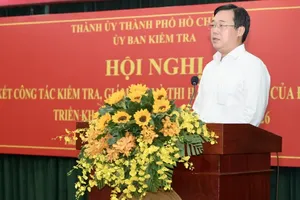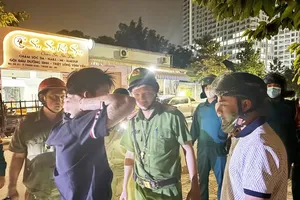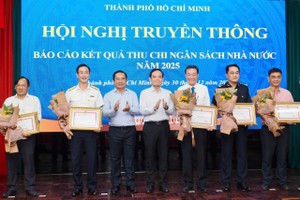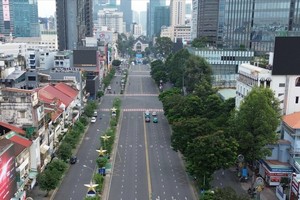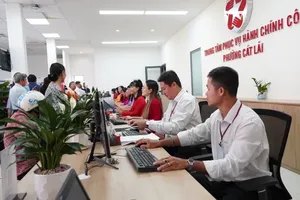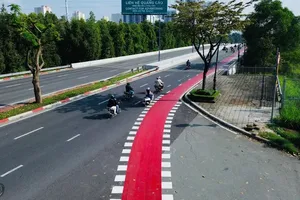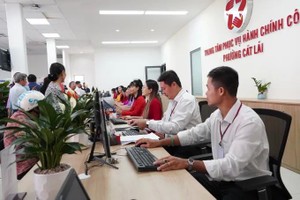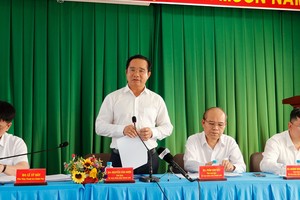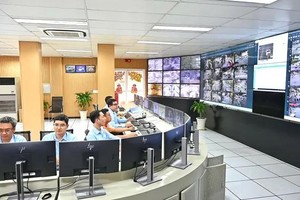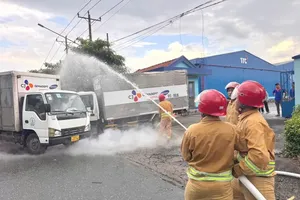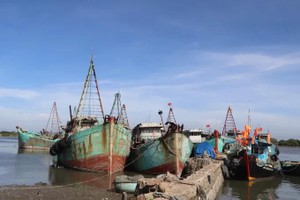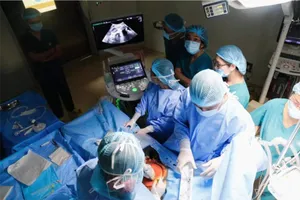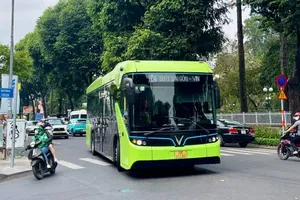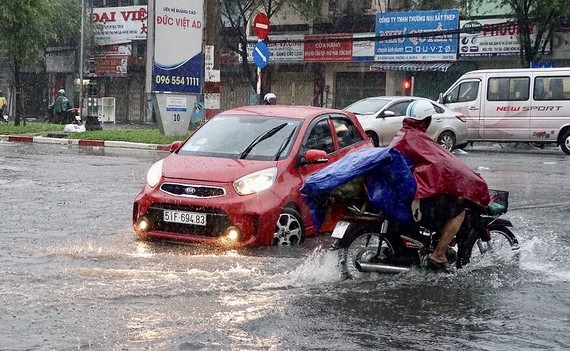
The heavy rain at various places in HCMC at the afternoon rush hour of June 2 lasted nearly 3 hours with a precipitation of 100mm, causing congestions due to urban flooding. The locations expected not to be flooded thanks to their height or upgraded infrastructure still shared the same fate as other areas in the city.
Nguyen Dung, living on Phan Huy Ich Street of Ward 12 in Go Vap District informed that whenever there is a downpour, his neighborhood experiences urban flooding. Water from outside penetrates houses and wet all furniture if there is a truck passing by.
Nguyen Van Qua Street nearby shares the same fate of serious urban flooding after each heavy rain, worse with high tides. Owner of a rice shop on this street Do Thi Bich Ngoc complained that business here is so slow owing to flooding after rain. Rainwater flows into alleys like mountain streams, making it impossible for business.
The rain on June 2 also flooded various streets in District 1 like Le Lai, Le Loi, Bui Vien, Huynh Thuc Khang, Nam Ky Khoi Nghia. Notably, these are the places marked ‘basically completing flooding eradication’ as the whole sewage system here has been renovated or replaced.
Former Head of the HCMC Institute for Construction Plan Hoang Minh Tri shared that it is lower from the North to the South; and that districts like Go Vap, 12, Hoc Mon, Cu Chi are 9 meters higher than the sea level. 15 years ago, these areas never experienced any urban flooding. The downtown area has its sewage draining system upgraded or replaced and hasn’t seen any flooding for many years until the June 2 downpour.
The Southern Region Hydro-Meteorological Centre has forecast that until June 20, there will be drizzles, showers, and even downpours in the South. The average precipitation should be at 30-90mm. This means that HCMC might be seriously flooded again, and that places marked ‘least likely to experience urban flooding’ are not correct anymore.
Prof. Ho Long Phi, former Director of the Center of Water Management and Climate Change (under Vietnam National University – HCMC), blamed this terrible situation on the uncontrolled concreting and canal leveling in HCMC.
Mr. Tri agreed with that, and added an example of flooding around Tan Son Nhat International Airport due to the illegal waste disposal into A41 Canal and Hy Vong Canal.
Aware of this the municipal authorities have increased management on construction projects and tried to eliminate uncontrolled canal leveling.
The Standing Committee of HCMC Party Committee has issued Direction No.19-CT/TU on October 19, 2018 about the campaign ‘HCMC Residents do not Dispose Waste into Canals for a Cleaner City without Urban Flooding’, in connection with the program to reduce environmental pollution from 2016-2020 as well as Resolution No.03/NQ-HDND TPHCM on June 11, 2017 on urban environment protection and waste management.
Adopting those policies, HCMC has basically control construction activities and illegal canal leveling in the city. However, the task of eliminating and handling illegal waste disposal is not as expected. Many sewer dredging and cleaning workers complain that people throw all kinds of things from old clothes to used plastic bags to sewers, severely obstructing water flow.
As the climate is changing and the frequency of downpours has increased significantly, many sewage draining systems in HCMC have become outdated. The designed cross-sections sewers in the basins of Nhieu Loc – Thi Nghe, Tan Hoa – Lo Gom, Tau Hu – Ben Nghe have been reported by scientists and experts to be unsuitable for the complicated changes of the weather nowadays. They are originally designed for the precipitation of 75-92mm, not the present 100-150mm.
Experts in the field stressed that fighting against urban flooding needs a comprehensive several-step solution, and investment in upgrading sewage systems is only one of them. The cooperation of all local residents like not disposing waste or level canals illegally all contribute to this fight.
Prof. Phi commented that establishing a regulating lake is one essential measure to help areas with overloaded sewage draining systems. Such a lake can be built anywhere, taking advantage of even sidewalk underground space. However, to launch this construction project, HCMC must develop a normative unit price list and specific technical standards for construction.
It is planned that HCMC will build 103 regulating lakes on the total surface area of 875ha to fight against urban flooding and condition the air. The Operation Center for HCMC Flood Control Program (now changed to HCMC Management Board for Investment in Urban Infrastructure Construction) proposed to build 3 such lakes from 2016-2020 in Go Duc of Thu Duc City, Khanh Hoi in District 4, and Bau Cat in Tan Binh District, with the total cost of VND950 billion (US$40.9 million). Sadly, financial and administrative challenges have prevented them from beginning.
At the beginning of 2021, HCMC People’s Committee approved the project ‘Fighting against Urban Flooding and Treating Sewage Water in the 2020-2045 Period’, including using regulating lakes. Accordingly, 7 lakes will be built at low areas in the city with the expense of VND1,500 billion ($64.6 million). Nevertheless, the exact positions for these lakes are still unidentified now.
Urban specialists shared that the short-term measures to reduce flooding in HCMC are to develop green spaces. However, most planned green spaces in the suburbs are associated with agricultural lots and damp rivers, not needy residential areas, which makes it harder to attract investments.
